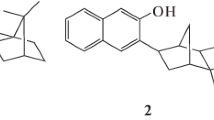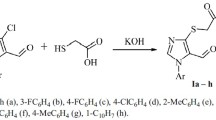Abstract
In this study, it was investigated whether sex-related differences in the protective mechanisms against oxygen radicals and free radical metabolites from drugs were present in rat liver, heart, and kidney. To that end, superoxide dismutase, catalase, the factors of the glutathione system and vitamin E were measured. In addition, NADPH-dependent cytochrome c-reductase activity was established, as this enzyme is involved in the formation of free radicals in the presence of many xenobiotics. The total capacity of the cellular systems that detoxify reactive oxygen species or free radical-drug metabolites seems to be higher in female liver as compared to male. No differences were found for heart and kidney tissue. It is hypothesized that female rats probably are less vulnerable for those drugs whose hepatotoxic action is induced by excessive formation of free radical species.
Similar content being viewed by others
References
Aebi H (1973) Catalase. In: Bergmeister HU (ed) Methods of enzymatic analysis vol III. Academic Press, New York, pp 673–683
Albano E, Poli G, Chiarpotto E, Biasi F, Dianzani MU (1983) Paracetamol-stimulated lipid peroxidation in isolated rat and mouse hepatocytes. Chem-Biol Interact 47: 249–263
Bachur NR, Gordon SL, Gee MV, Kon H (1979) NADPH cytochrome P-450 reductase activation of quinone anticancer agents to free radicals. Proc Natl Acad Sci USA 76: 954–957
Fairhurst S, Barber DJ, Clark B, Horton AA (1982) Studies on paracetamol-induced lipid peroxidation. Toxicology 23: 249–254
Griffith OW (1980) Determination of GSH and GSSG using glutathione reductase and 2-vinylpyridine. Anal Biochem 106: 207–212
Haenen GRMM, Bast A (1983) Protection against lipid peroxidation by a microsomal glutathione-dependent labile factor. FEBS Lett 159: 24–28
Jones DP, Eklöw L, Thor H, Orrenius S (1981) Metabolism of hydrogen peroxide in isolated hepatocytes: Relative contributions of catalase and glutathione peroxidase in decomposition of endogenously generated H2O2. Arch Biochem Biophys 210: 505–516
Kappus H, Sies H (1981) Toxic drug effects associated with oxygen metabolism: redox cycling and lipid peroxidation. Experientia 37: 1233–1241
Kornburst DJ (1980) Microsomal lipid peroxidation. II. Stimulation by CCl4. Mol Pharmacol 17: 408–414
Lawrence RA, Burk RF (1978) Species, tissue and subcellular distribution of non Se-dependent GSH-Px activity. J Nutr 108: 211–215
McCay PB, King MM (1980) Vitamin E: its role as a biologic free radical scavenger and its relationship to the microsomal mixed-function oxidase system. In: Machlin L (ed) Vitamin E, a comprehensive treatise. Dekker M Inc, New York, pp 289–317
McCay PB, Gibson DD, Hornbrook KR (1981) Glutathione-dependent inhibition of lipid peroxidation by a soluble heat labile factor not glutathione peroxidase. Fed Proc 40: 199–205
Mimnaugh EG, Trush MA, Gram TE (1981) Stimulation by adriamycin of rat heart and liver microsomal NADPH-dependent lipid peroxidation. Biochem Pharmacol 30: 2797–2804
Myers CE, McGuire WP, Liss RH, Ifrim I, Grotzinger K, Young RC (1977) Adriamycin: the role of lipid peroxidation in cardiac toxicity and tumor response. Science 197: 165–167
Ozawa T, Hanaki A, Matsuo M (1983) Reactions of superoxide ion with tocopherol and its model compounds: correlations between the physiological activities of tocopherol and the concentration of chromanoxyl-type radicals. Biochem Int 6: 685–692
Ragnotti G, Lawford GR, Campbell PN (1969) Biosynthesis of microsomal NADPH cytochrome c-reductase by membrane bound and free polysomes from rat liver. Biochem J 112: 139–147
Raheja KL, Linscheer WG, Cho C (1983) Hepatotoxicity and metabolism of acetaminophen in male and female rats. J Toxicol Environ Health 17: 143–158
Rammel CG, Cunliffe B, Kieboom AJ (1983) Determination of α-tocopherol in biological specimens by high-performance liquid chromatography. J Liquid Chromatogr 6: 1123–1130
Sekura R, Meister A (1974) Glutathione turnover in the kidney: Considerations relating to gamma-glutamyl cycle and transport of amino-acids. Proc Natl Acad Sci USA 71: 2969–2972
Siegers CP, Riechl W, Younes M (1984) Sex-differences in the susceptibility of rats to carbon tetrachloride-alcohol induced liver injury. Agents and Actions 14: 121–124
Smith MT, Thor H, Orrenius S (1983) The role of lipid peroxidation in the toxicity of foreign compounds to liver cells. Biochem Pharmacol 32: 763–764
Trush MA, Mimnaugh EG, Gram TE (1982) Activation of pharmacological agents to radical intermediates. Implications for the role of free radicals in drug activity and toxicity. Biochem Pharmacol 31: 3335–3346
Weisiger RA, Fridovich I (1973) Superoxide dismutase. J Biol Chem 248: 3582–3592
Wendel A, Feuerstein S, Konz KH (1979) Acute paracetamol intoxication of starved mice leads to lipid peroxidation in vivo. Biochem Pharmacol 28: 2051–2055
Wendel A, Feuerstein S (1981) Drug induced lipid peroxidation in mice. I. Modulation by monooxygenase activity, glutathione and selenium status. Biochem Pharmacol 30: 2513–2520
Worthington DJ, Rosemeyer MA (1974) Human glutathione reductase: Purification of the crystalline enzyme from erythrocytes. Eur J Biochem 48: 167–177
Author information
Authors and Affiliations
Rights and permissions
About this article
Cite this article
Julicher, R.H.M., Sterrenberg, L., Haenen, G.R.M.M. et al. Sex differences in the cellular defence system against free radicals from oxygen or drug metabolites in rat. Arch Toxicol 56, 83–86 (1984). https://doi.org/10.1007/BF00349076
Received:
Accepted:
Published:
Issue Date:
DOI: https://doi.org/10.1007/BF00349076




